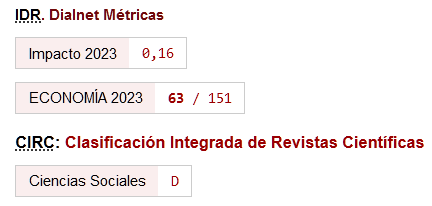¿Qué preocupa a los gobiernos, la brecha de producción o el PIB?
Keywords:
Fiscal policy, Cycle stabilization, MacroeconomicsAbstract
Indicators of the cyclical position of an economy are a key input for both implementation and analysis of fiscal policy. This position just determines the way in which fiscal authorities responds. In both academic literature and international institutions, a recession is defined in terms of the cyclical position of an economy(,) depending on the level of the output-gap.However, are Government fiscal decisions triggered by the output-gap or by the change in the GDP? This is particularly important in the assessment of fiscal policy, because its stabilizing role may change depending on the chosen variable.
Downloads
References
Afonso, A. y Hauptmeier, S. (2009): "Fiscal behaviour in the European Union. Rules, fiscal decentralization and government indebtness", European Central Bank Working Paper Series, 1054. https://doi.org/10.2139/ssrn.1399284
Banco Central Europeo (2000): "Crecimiento del producto potencial y brechas de producción", Boletín Mensual (Octubre).
-(2002): "Funcionamiento de los estabilizadores fiscales automáticos en la zona del euro", Boletín Mensual (Abril).
-(2007): "Los problemas metodológicos de los saldos ajustados de ciclo: el caso de la UEM", Boletín Mensual (Junio).
Blinder, A. (2006): "The case against the case against discretionary fiscal policy", en Kopcke, R.W., Tootell, M.B. y Triest, K. (Eds), The macroeconomics of fiscal policy. MIT Press, Cambridge, EE.UU., 25-74.
Calmfors, L. (2003): "Fiscal policy to stabilise the domestic economy in the EMU: what can we learn", CESifo Economic Studies, 49,3.
https://doi.org/10.1093/cesifo/49.3.319
Cimadomo, J. (2008). "Fiscal Policy in real time", ECB Working Paper Series nº 919. https://doi.org/10.2139/ssrn.1157775
Comisión Europea (2005): "New and updates budgetary sensitivities for the EU budgetary surveillance", Directorate General for Economic and financial affairs (septiembre).
-(2006): "Calculating potential growth rates and output gaps - A revised production function approach -", Economic Papers, 247, marzo.
-(2009): "Cyclical Adjustment of Budget Balances", Directorate General for Economic and financial affairs (otoño).
DeRoose, S., Larch, M. y Schaechter, A (2008): "Constricted, lame and procyclical?. Fiscal policy in the euro area revisited", European Commision, Economic and Financial Affairs Economic Papers, 353.
Égert, B. (2010): "Fiscal policy reaction to the cycle in the OECD: Pro- or Counter-cyclical?", OCDE Economic Deparment Working Paper 763.
Fatás, A. y Mihov, I. (2009): "The euro and fiscal policy", NBER Working Paper nº 14722. https://doi.org/10.3386/w14722
Girouard, N. y André, C. (2005): "Measuring Cyclically adjusted Budget Balances for OECD Countries", OECD Economics Department Working Papers, 434, OECD Publishing. https://doi.org/10.1787/787626008442
Girouard, N. y Price, R. (2004): "Asset Price Cycles, 'One-Off' Factors and Structural Budget Balances", OECD Economics Department Working Papers, No. 391, OECD, Paris.
Lane, P. (2003): "The cyclical behaviour of fiscal policy: evidence from the OECD", Journal of Public Economics, 87, 2661-2675.
https://doi.org/10.1016/S0047-2727(02)00075-0
Leigh, D. y Stehn, J. (2009): "Fiscal and Monetary Policy During Downturns: Evidence from the G7". FMI WP 09/50 (marzo).
https://doi.org/10.5089/9781451871982.001
OCDE (2008a): "Revision of quarterly output gap estimates for 15 OCDE member countries", OECD Statistics Directorate (Septiembre).
-(2008b): "The usefulness of output gaps for policy analysis", OECD Economic Department working paper, 621.
-(2008c): "Accounting for one-off operations when assessing underlying fiscal position", OECD Economic Department working paper, 642.
Downloads
Published
How to Cite
Issue
Section
License
This licence allows third parties to share (copy and redistribute the material in any medium or format) and adapt (remix, transform and create from the material for any purpose, including commercial purposes), provided that authorship and first publication in this journal (The Journal, DOI of the work) is acknowledged, a link to the licence is provided, and it is stated whether changes have been made to the work.







